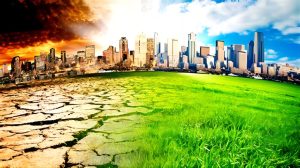11 Climate Justice and Health impacts
Charles Chen

The complexity of climate justice
Some countries and populations have benefited more from the industries and technologies causing climate change. And at the same time, the countries that have benefited the least are more likely to be suffering first and worst because of climate change. “The impact of climate change on vulnerable communities raises ethical questions about who should help them cope and how. Research shows that equitable and beneficial solutions are possible, but they always come with risks.”
Climate justice refers to the principle of equitable distribution of the benefits of activities that cause climate change and the burden of climate change impacts. Climate justice means that countries that became wealthy through unrestricted carbon emissions have the greatest responsibility to stop warming the planet, help other countries adapt to climate change, and develop economically with nonpolluting technologies.
Climate justice also requires fairness in environmental decision-making. This principle advocate uniting populations least responsible and vulnerable to the climate crisis as decision-makers in global and regional plans to respond to the crisis. It also means recognizing that climate change threatens a fundamental human rights principle that all human beings are born with equal dignity and rights including food water and other resources necessary to maintain health. According to MIT, calls for climate justice rather than climate action focus on how the various responses to climate change distribute damages and benefits and who has a role to play in shaping these responses and influencing policy decisions. Scholarship diplomacy and activity influence.
Rich industrialized countries have released most of the greenhouse gas pollution to date which means they play a major role in causing climate change. Climate justice calls on countries and multinational companies that have paid their climate debt to pollute industries to the rest of the world. In this context the reduction of greenhouse gas emissions although important is not enough to fully repay the pollution debt of more than a century; These actors also have an obligation to share the wealth of technology and other benefits of industrialization with those less responsible for the climate. crisis by helping them address the impacts of climate change and build clean energy systems and industries.
The idea of climate justice has also drawn attention to inequalities within countries. For example, Island nations are particularly vulnerable to the effects of climate change, including changes in sea level, storms, coastal erosion, and freshwater availability. Some findings show that respondents in biophysically vulnerable island states are more concerned about resettlement due to climate change and are also more likely to express sadness and anger.[1]
The relationship between climate change and health equity
Climate change poses a present and growing threat to human health. The continued warming of the climate will lead to increased risks to human health, exacerbating existing health threats and creating new health challenges. This is one of the serious threats posed by climate change to human beings.
Many vulnerable communities currently suffer unequally from climate-induced health risks, such as lack of water in extremely hot climates, poor air quality, living in places with frequent flooding, and year-round exposure to extreme weather events and disease.
Many factors contribute to a person’s ability to cope with the health effects of climate change, such as
- Living in areas that are very vulnerable to climate change (like communities along the coast or extreme weather)
- Coping with higher levels of existing health risks when compared to other groups
- Living in low-income communities with limited access to healthcare services
- Limited access to quality healthcare
- Limited availability of information and resources in a person’s native language
- Limited ability to relocate or rebuild after a disaster

The effects of climate change can worsen existing differences in health, adding to other longstanding differences among people that result in different health outcomes for communities in the United States. These differences include poor living conditions, racism and other forms of discrimination, and psychological stresses.
Climate change is already increasing the severity or frequency of health threats occurring in some areas not only in physical health but also in mental health. In other areas, climate change’s effect on land, water, and air quality can cause new health problems where they hadn’t previously occurred.
Seasonal Changes: Seasonal changes can shift the geographic area where disease-carrying insects, such as mosquitoes, ticks, and fleas transmit West Nile Virus, dengue fever, Lyme disease, and malaria to humans.
Air Quality: Increasing exposure to pollen due to increased plant growing seasons, molds due to severe storms, and air pollution due to increased temperature and wildfires, can all worsen lung diseases, such as asthma.

Heat: More frequent and severe heat waves lead to more heat-related illnesses and deaths. For example, wildfire. Two studies from North America examined the impact of wildfires on mental health. Qualitative interviews
with a purposeful sample of individuals in the context of climate change, including broad cross-sectional background and experiences from the severe 2014 wildfire season in the Northwest Territories of Canada, reporting experiences of evacuation and isolation and how fear, stress, and uncertainty Serious and long-term negative effects on mental and emotional health. Increased time indoors, disrupted livelihoods, and land-based activities, negatively impact mental health.[2]
 Temperature Changes: Increasing temperatures can cause poor air quality that affects the heart and worsens the cardiovascular disease. Three studies from Australia found associations between heat and mental health outcomes; however, the evidence was inconsistent. For example, Ding et al., report that an increase in temperature and humidity affects psychological distress, independently from pre-existing depression or anxiety.[3] Similarly, another study that looked at data from Adelaide, Australia, found that while there was a positive association between temperatures exceeding the maximum and minimum thresholds (32 °C and 16 °C) and psychiatric presentations to the emergency department, there was a significant decrease in this effect when temperatures were considered extreme.[4] A third study conducted on children in Australia showed a small effect of worsened childhood mental health with an increase in annual average daily maximum temperatures.[5] Although these examples are from Australian forests, the same thing happens in Pacific Northwest Forest.
Temperature Changes: Increasing temperatures can cause poor air quality that affects the heart and worsens the cardiovascular disease. Three studies from Australia found associations between heat and mental health outcomes; however, the evidence was inconsistent. For example, Ding et al., report that an increase in temperature and humidity affects psychological distress, independently from pre-existing depression or anxiety.[3] Similarly, another study that looked at data from Adelaide, Australia, found that while there was a positive association between temperatures exceeding the maximum and minimum thresholds (32 °C and 16 °C) and psychiatric presentations to the emergency department, there was a significant decrease in this effect when temperatures were considered extreme.[4] A third study conducted on children in Australia showed a small effect of worsened childhood mental health with an increase in annual average daily maximum temperatures.[5] Although these examples are from Australian forests, the same thing happens in Pacific Northwest Forest.
 Flooding: Flooding events can contaminate water with harmful bacteria, viruses, and chemicals that cause foodborne and waterborne illnesses. Several studies examined the mental health impacts of flooding. An Australian study qualitatively explored individuals’ experiences from rural communities, concluding that the threat of drought and flood are intertwined and contributed to decreased well-being from stress, anxiety, loss, and fear. [6] A cohort study from the UK looking at the long-term impact of flooding found psychological morbidity persisted for at least three years after the flooding event. [7]
Flooding: Flooding events can contaminate water with harmful bacteria, viruses, and chemicals that cause foodborne and waterborne illnesses. Several studies examined the mental health impacts of flooding. An Australian study qualitatively explored individuals’ experiences from rural communities, concluding that the threat of drought and flood are intertwined and contributed to decreased well-being from stress, anxiety, loss, and fear. [6] A cohort study from the UK looking at the long-term impact of flooding found psychological morbidity persisted for at least three years after the flooding event. [7]
 Severe Weather: In addition to injuries, illnesses, and deaths, more frequent and severe extreme weather events can harm mental health due to damage to property, loss of loved ones, displacement, and chronic stress.
Severe Weather: In addition to injuries, illnesses, and deaths, more frequent and severe extreme weather events can harm mental health due to damage to property, loss of loved ones, displacement, and chronic stress.
Health Care System Impacts: Extreme climate events can place added stress on hospital and public health systems and limit people’s ability to obtain adequate health care during crises
- Emotion, Coping, and Climate Change in Island Nations: Implications for Environmental Justice Margaret V. du Bray, Amber Wutich, Kelli L. Larson, Dave D. White, and Alexandra Brewis Environmental Justice 2017 10:4, 102-107 ↵
- Dodd W., Scott P., Howard C., Scott C., Rose C., Cunsolo A., Orbinski J. Lived experience of a record wildfire season in the Northwest Territories, Canada. Can. J. Public Health Rev. Can. De Sante Publique. 2018;109:327–337. doi: 10.17269/s41997-018-0070-5. ↵
- Ding N., Berry H.L., Bennett C.M. The Importance of Humidity in the Relationship between Heat and Population Mental Health: Evidence from Australia. PLoS ONE. 2016;11:e0164190. doi: 10.1371/journal.pone.0164190. ↵
- Williams S., Nitschke M., Sullivan T., Tucker G.R., Weinstein P., Pisaniello D.L., Parton K.A., Bi P. Heat and health in Adelaide, South Australia: Assessment of heat thresholds and temperature relationships. Sci. Total Environ. 2012;414:126–133. doi: 10.1016/j.scitotenv.2011.11.038. ↵
- Xu Y., Wheeler S.A., Zuo A. Will boys’ mental health fare worse under a hotter climate in Australia? Popul. Environ. 2018;40:158–181. doi: 10.1007/s11111-018-0306-6. ↵
- Ng F.Y., Wilson L.A., Veitch C. Climate adversity and resilience: The voice of rural Australia. Rural Remote Health. 2015;15:3071. ↵
- Mulchandani R., Armstrong B., Beck C.R., Waite T.D., Amlôt R., Kovats S., Leonardi G., Rubin G.J., Oliver I. The English National Cohort Study of Flooding & Health: Psychological morbidity at three years of follow up. BMC Public Health. 2020;20:321. doi: 10.1186/s12889-020-8424-3. ↵

